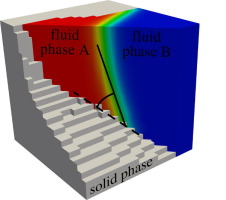Journal of Colloid and Interface Science ( IF 9.4 ) Pub Date : 2018-03-17 , DOI: 10.1016/j.jcis.2018.02.075 Florian Frank , Chen Liu , Alessio Scanziani , Faruk O. Alpak , Beatrice Riviere

|
We consider an energy-based boundary condition to impose an equilibrium wetting angle for the Cahn–Hilliard–Navier–Stokes phase-field model on voxel-set-type computational domains. These domains typically stem from (micro computed tomography) imaging of porous rock and approximate a (on scale) smooth domain with a certain resolution. Planar surfaces that are perpendicular to the main axes are naturally approximated by a layer of voxels. However, planar surfaces in any other directions and curved surfaces yield a jagged/topologically rough surface approximation by voxels. For the standard Cahn–Hilliard formulation, where the contact angle between the diffuse interface and the domain boundary (fluid–solid interface/wall) is , jagged surfaces have no impact on the contact angle. However, a prescribed contact angle smaller or larger than on jagged voxel surfaces is amplified. As a remedy, we propose the introduction of surface energy correction factors for each fluid–solid voxel face that counterbalance the difference of the voxel-set surface area with the underlying smooth one. The discretization of the model equations is performed with the discontinuous Galerkin method. However, the presented semi-analytical approach of correcting the surface energy is equally applicable to other direct numerical methods such as finite elements, finite volumes, or finite differences, since the correction factors appear in the strong formulation of the model.
中文翻译:

锯齿状表面上基于能量的平衡接触角边界条件用于相场方法
我们考虑基于能量的边界条件,在体素集类型的计算域上为Cahn–Hilliard–Navier–Stokes相场模型施加平衡的润湿角。这些域通常源自 (微计算机断层扫描)成像的多孔岩石和近似(上 比例)平滑域具有一定的分辨率。垂直于主轴的平面自然由一层体素近似。但是,在任何其他方向上的平面表面和曲面都会通过体素产生锯齿状/拓扑粗糙的表面近似值。对于标准的Cahn–Hilliard公式,扩散界面与区域边界(流体–固体界面/壁)之间的接触角为,锯齿状的表面对接触角没有影响。但是,规定的接触角小于或大于锯齿状体素表面上的信号被放大。作为一种补救措施,我们建议为每个流体-固体体素面引入表面能校正因子,以平衡体素设置表面积与基础光滑面之间的差异。使用不连续的Galerkin方法对模型方程式进行离散化。但是,由于校正因子出现在模型的强公式中,因此所提出的校正表面能的半分析方法同样适用于其他直接数值方法,例如有限元,有限体积或有限差分。











































 京公网安备 11010802027423号
京公网安备 11010802027423号